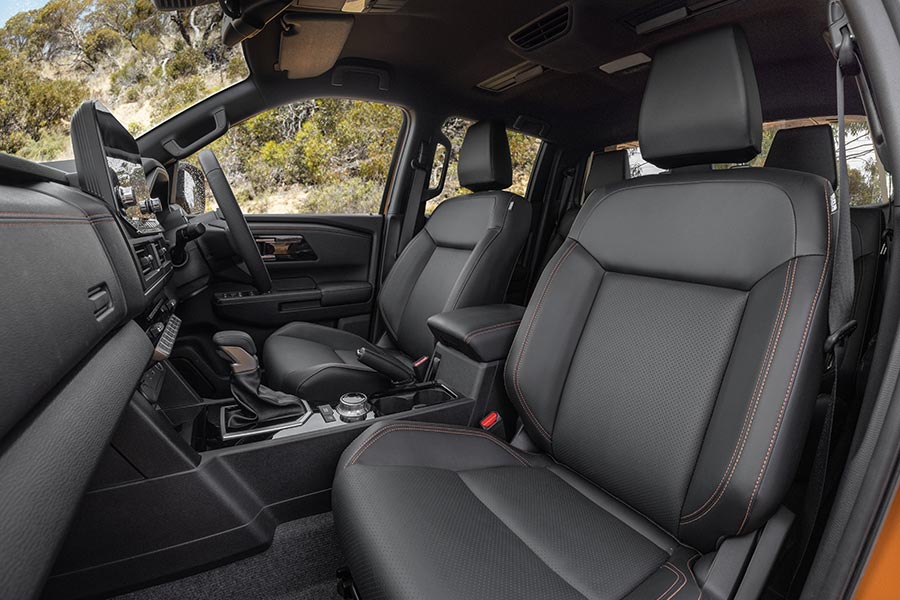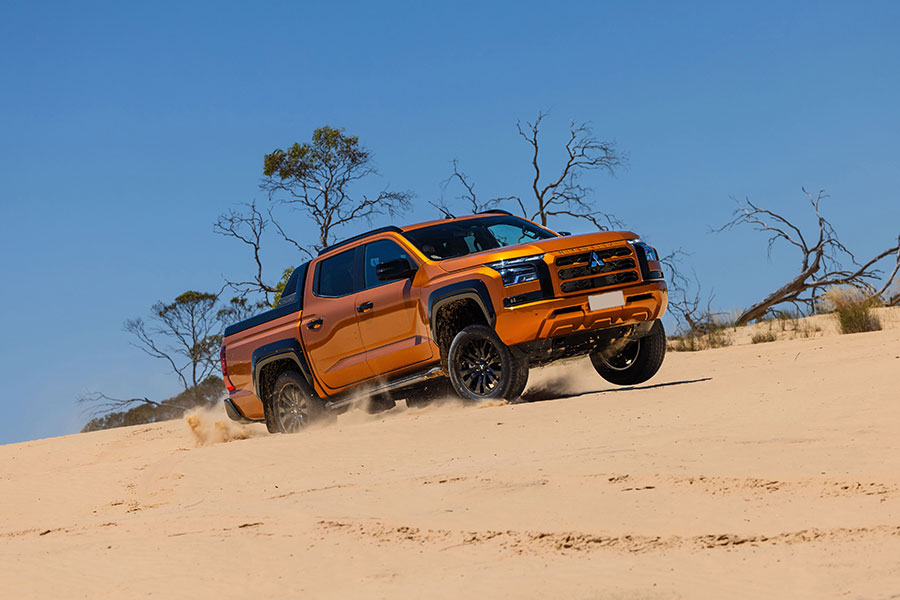Whether you’re ready to get started or would like to know more, we’re here to help.
By Sam Charlwood, carsales.com.au
Australians have always admired an underdog, but they love a winner. That much is true whether it is choosing a footy team or the car they drive. And, in the battle of the ‘burbs, the Mitsubishi Triton has long been revered as an unsung hero among the dual-cab ute.
It’s never been the champion against powerhouse rivals like the Toyota HiLux and Ford Ranger, as it hasn’t had the firepower to match them on performance, power, or payload. But the Triton has always punched well above its weight, by undercutting its competitors on value.
Now though, Mitsubishi reckons it has a genuine contender with its all-new sixth-generation Triton which offers more of everything but loses its competitive price position.
Is it truly the new benchmark? Our first impressions yielded some mixed results. Let’s find out why.
How much does the Mitsubishi Triton cost?
The 2024 Mitsubishi Triton arrives with a six-model line-up that starts at $43,690 (plus on-roads) for the entry-level GLX Double Cab Pick-Up with rear-wheel drive, which is $3200 more expensive than the equivalent model it replaces.
The range then moves through five versions with four-wheel drive, which starts with the only Club Cab model, the GLX+ at $50,340 (plus ORCs), then four variants of the Double Cab; GLX, GLX+, GLS and the flagship GSR we’re testing here which costs from $63,840 (plus ORCs). That’s a $7000 increase over its predecessor.
Work-ready single-cab and cab-chassis versions of the Triton are expected later in 2024. Mitsubishi has confirmed that models lower in the hierarchy will also be offered with a manual transmission, whereas the opening launch range is automatic-only.
While prices have increased significantly across the range, the Triton continues to undercut comparable versions of the Ford Ranger (starting from $43,280 plus ORCs) and Toyota HiLux (from $44,635 plus ORCs), though it moves further away from more affordable alternatives such as the GWM Ute (from $35,990 drive-away).
It means the Triton doesn’t quite hold the same compelling value equation it once did in Australia.
What equipment comes with the Mitsubishi Triton?
Even the most basic versions of the 2024 Mitsubishi Triton receive a modest increase in equipment levels along with wholesale changes in design, space and power.

In overall terms, the new Triton dual-cab is 15mm longer than before (5320mm), 50mm wider (1865mm) and rides on a 130mm-longer (3130mm) wheelbase, liberating a 35mm-longer tray (1555mm) and 49mm more shoulder-room (1479mm).
The Triton runs a ladder-frame chassis as before and has updated high-mount double-wishbone front suspension with increased travel, with a revised leaf spring layout at the rear – both complemented by larger-diameter shock absorbers.
The entry GLX is fitted with 17-inch alloy wheels and has cloth seat trim, keyless entry (though not keyless start), tyre pressure monitoring and air-conditioning.
The GSR flagship tested here brings 18-inch wheels, LED headlights, taillights, indicators and fog lights, dual-zone climate control, heated front seats, rear styling bar, roof rails, leather seat trim with contrasting orange stitching, soft interior padding, dash-mounted cup holders and power adjustment for the driver’s seat (but not the front passenger).
A quick flick through the specifications list reveals many creature comforts are exclusive to models higher in the range, while accessories including a tow bar are optional across the line-up. Other manufacturers are beginning to offer a tow bar standard on some models.
There’s a more positive story around aftersales, however.
Mitsubishi Australia ordinarily covers all its vehicles with a standard a five-year/100,000km warranty in Australia. However, if buyers follow the prescribed servicing scheduled through the car-maker’s national dealer network, the factory provision stretches to a 10-year/200,000km warranty with a 10-year capped-price servicing program (priced at $6690 over 10 years/150,000km, based on 12-month/15,000km intervals).
The manufacturer is also offering a full suite of accessories in-house with the new Triton, with items including a steel bull bar and underside protection, bonnet protector, snorkel, canopy, rear protection bar, sports bar, side protection bar and bed liner.
What technology does the Mitsubishi Triton feature?
The entire 2024 Mitsubishi Triton range gains a new 9.0-inch centre touchscreen display that controls all the key infotainment functions, including Apple CarPlay and Android Auto (both wired and wireless).
Higher-spec versions also offer digital radio, sat-nav and a wireless phone charging pad.
A bank of physical buttons and switchgear offers straight-forward access to simple functions, or shortcuts on the screen – to save you digging through needless sub-menus.

Elsewhere, the instrument cluster now gets a 7.0-inch digital readout that sits between two analogue gauges.
The display is clean and legible, though a far cry from full-length digital instrument clusters offered in rivals – most notably, the latest Ford Ranger.
What is the Mitsubishi Triton like inside?
From any seat inside the cabin of the new 2024 Mitsubishi Triton, occupants will notice a range of notable improvements, especially in the case of our GSR flagship.
Above all else, the longer wheelbase has extracted more space for rear seat passengers than before, allowing the Triton to stand up as one of the more spacious offerings in the class.

There is an obvious emphasis on the use of nicer materials and presentation, the updated dashboard design is more contemporary, and the cabin is littered with nifty storage solutions and amenity.
However, the Triton doesn’t quite match the sophistication of a higher-spec Ford Ranger, with harder surface treatments and obvious cost short-cutting, including a solid plastic circle on the steering column of our GSR test vehicle where a key barrel would usually reside on cheaper models.
Occupants are provided with the choice of USB-A and USB-C outlets in both rows of seating, while rear occupants also have access to roof-mounted air vents, though no vents at the traditional rear of the centre console.
The rear seat space is accommodating and suitable for a couple of adults on moderate journeys, accessed by dual grab rails on either side plus side steps on higher-specification models.
While the Triton offers ISOFIX child seat attachment points for the outboard rear seating positions, it makes do with a solitary top tether strap point behind the middle seat (instead of three solid individual top tether points across the bench).
It means occupants need to make use of a fiddly fabric looping strap to secure child seats, and they’re never quite as snug or secure as devoted top tether points behind each seat.
How safe is the Mitsubishi Triton?
The 2024 Mitsubishi Triton ushers in a host of new safety equipment that’s likely to lead to a five-star ANCAP safety rating in the future. It has yet to be tested by the independent crash testing authority.

This includes eight airbags, front and rear autonomous emergency braking (AEB) – the former with pedestrian and cyclist detection and junction assist – plus adaptive cruise control, lane change assist/blind spot warning, front and rear cross traffic alert, traffic sign monitoring and intelligent speed alert are all standard.
But - and this is a big but - there is a massive caveat around the intervention of some of these systems. This is most notably the case for the driver attention system and speed alert systems.
The former erroneously barks at the driver if they take a cursory glance away from the road, yawn, blink and much more. We can see the appeal – and understand the system’s value in ensuring a fleet-friendly five-star rating – but the interaction is annoying. And what’s more, you have to turn it off every time you start the car.
What powers the Mitsubishi Triton?
The 2024 Mitsubishi Triton is powered by what Mitsubishi claims is an “all-new” turbo-diesel engine. But the truth is it shares much in common with its predecessor.

The identical-capacity 2.4-litre diesel now employs two turbos – a small turbo for fast response at low revs and a larger turbo for top-end performance – to raise output to 150kW and 470Nm, a circa-10 per cent increase on both counts.
New pistons are said to be responsible for the power bump, while hydraulic valve lash adjusters are said to reduce maintenance. Happily, the Triton retains a timing chain, which is also good news for servicing costs.
The Triton’s six-speed automatic is virtually unchanged, though Mitsubishi has tweaked gear ratios to suit the uprated power and torque outputs.
The revised engine features a 17-litre AdBlue reservoir to ensure the Triton complies with the latest Euro 6B emissions regulations and can comfortably transition to more stringent targets on the immediate horizon.
Mitsubishi says development of the new Triton began in 2017, well before the release of new models including the Ford Ranger, the Ford-led Volkswagen Amarok and forthcoming all-new Toyota HiLux.
How fuel efficient is the Mitsubishi Triton?
Mitsubishi Australia claims the Triton has a combined fuel consumption average of 7.7L/100km, although we achieved around 9.5L/100km in a mix of conditions on launch, which included open-road and off-road driving.
What is the Mitsubishi Triton like to drive?
The 2024 Mitsubishi Triton takes a modest step forward with its on-road manners and refinement.

The new electrically assisted steering immediately imparts more lightness and refinement to the driver’s hands, helping offset the Triton’s larger turning circle while also eliminating its predecessor’s unnecessary levels of feedback.
The diesel engine offers a familiarly rugged character, shaking to life before settling into a muted thrum in regular conveyance. The start-up ‘shake’ is particularly noticeable in crawling traffic, where its new idle stop-start system takes effect.
The Triton feels marginally more settled than before in terms of its ride, and the larger footprint has yielded moderately more stability through corners and changes in direction.
Then again, there are some newer features that take away from the Triton’s charm. Namely, its safety systems.
The combination of driver attention monitoring and speed sign recognition becomes infuriating at times, with a cacophony of chimes and bells constantly sounding should you decide to momentarily veer your eyes away from straight-ahead, change speed zones or climb even 1km/h above the speed limit.
We’re all for safety, but these systems are a hindrance rather than a help, and a potential deal-breaker for prospective buyers.
Elsewhere, there are elements of the Triton driving experience which are largely the same as before.
For all its new parts and marketing hyperbole, the engine operates largely the same as before: it spins up nicely from around 1500rpm and delivers ample power and torque for around-town passage.
The six-speed automatic gearbox naturally pushes for economy and will kick down gears under harder acceleration to keep the engine at its sweet spot. However, the transmission lacks the intuitiveness and ratio count of more superior units on the market, while the engine can become quite vocal and strained as you push past the middling revs.
Moreover, Mitsubishi’s decision to delete the Triton’s steering wheel-mounted paddle shifters could potentially complicate downshifting under braking, especially when towing.
The fact the Triton still runs rear drum brakes and doesn’t take any giant leaps forward in engine performance should be considered if regularly towing heavy loads. That’s despite the 400kg increase in braked towing capacity (to 3500kg).
Similarly, while there are marginal improvements with the Triton’s ride, it is still afflicted by tremoring that is commonplace on most dual-cab utes, a virtue of load-rated leaf springs.
In earnest, the Triton still feels like one of the fussiest rides going, busy and fidgety over low-speed bumps and more susceptible to larger washouts in the road at high speeds. These traits are compounded by relatively noisy levels of road and cabin noise.
It means the Triton is mostly civilised and easy to live with but doesn’t really move the needle from a driving standpoint.
How good is the Mitsubishi Triton off-road?
If you intend to travel off the beaten track, then the new 2024 Mitsubishi Triton is a surprisingly capable jigger off-road, especially in flagship trim when the Super Select II 4x4 system and rear-locking diff is fitted standard.

During the national launch, we drove across a 45-minute off-road loop with some modest climbs and descents with plenty of opportunities to assess its wheel articulation as well as a short stint on sand.
In truth, there was nothing on the circuit to really ‘frighten the Triton’ or indeed test just how far it would go.
We didn’t go too far in exploring its seven different off-road modes, but occasionally took issue with the intervention of the stability control, which would sometimes completely stop forward progress, and the dullness of its accelerator pedal.
That said, the lightness of the new electrically assisted steering is a boon when navigating tight obstacles and turns.
How much can the Mitsubishi Triton carry?
Significantly, the 2024 Mitsubishi Triton now brings an upgrade that matches its rivals for towing capacity, a 400kg increase over its predecessor to a maximum 3.5 tonne with a braked trailer.

A maximum downball weight of 350kg applies to all Triton variants.
Where the Triton does carry some cache is around payload when towing the full 3500kg – a virtue of its lighter circa-2.1t kerb weight – with a gross combination mass of 6250kg.
Unladen payload for both the GLS at 1115kg and 1085kg for the GSR is also the best of the premium utes.
It means the GLS can handle a 665kg payload while towing 3500kg and the GSR 635kg. At 3000kg, the respective numbers are 815kg and 785kg.
The tray in the new MY24 Triton dual-cab is 35mm longer at 1555mm and 75mm wider at 1545mm. The gap between the wheel-arches is up 50mm to 1135mm, which means it still cannot fit an Aussie pallet (1165x1165mm).
There are four fixed tie-down points (no moveable fixtures) as standard, however there is no tailgate assistance, no rear tub lighting, and no power outlet.
What’s more, the Triton misses out on integrated electric brakes fitted standard to the Ford Ranger, meaning those that tow heavier loads will need to pony up for an aftermarket system, as well as a tow bar.
Should I buy a Mitsubishi Triton?
There has arguably never been a better time to buy a ute in Australia. The choices are plentiful, and there is a noticeable improvement in polish, performance, and refinement with the latest-generation models.

If we’re honest, while the new 2024 Mitsubishi Triton is significantly better than the model it replaces it doesn’t really move the needle in any one area. If anything, the latest round of changes merely helps to keep pace with segment leaders.
Equally, the pricing increases mean the Triton doesn’t quite uphold the value equation of its forebears. Certainly not in the same way as the GWM Ute does.
It means the new Triton is sound and dependable, addressing some of the shortfalls of previous Triton models while also presenting some new ones at the same time.
2024 Mitsubishi Triton GSR Double Cab Pick-Up 4x4 at a glance:
Editor’s Rating: 7.5/10
| Price: $63,840 (plus on-road costs) |
Transmission: Six-speed automatic |
| Available: Now |
Fuel: 7.7L/100km (ADR Combined) |
| Engine: 2.4-litre four-cylinder twin-turbo diesel |
CO2: 203g/km (ADR Combined) |
| Output: 150kW/470Nm |
Safety Rating: Not tested |
Disclaimer: Images supplied by Mitsubishi Australia.
This article was prepared by an independent author. The information contained in this article represents the views and opinions of the original author, and is based on research carried out by the original author. The appearance of the article on Maxxia's website does not constitute an endorsement of its content by Maxxia in any way. The article has been made available for informational purposes only and should not be taken as advice. While all reasonable care has been taken to ensure that the statements made by the original author in the article are fair and accurate, Maxxia does not guarantee or warrant the accuracy or completeness of this information and will not be liable for, or in connection with, any loss or damage suffered as a result of any inaccuracies, errors or omissions or your reliance on this information. You should independently research and verify information before making any decision in respect of a vehicle.


